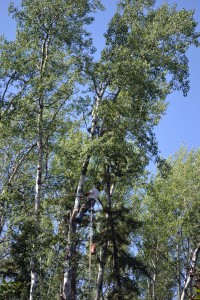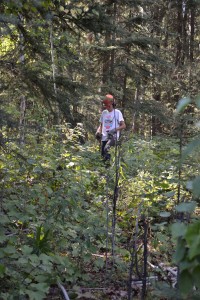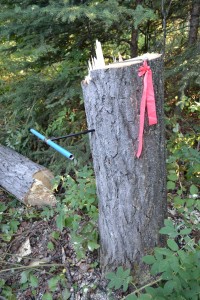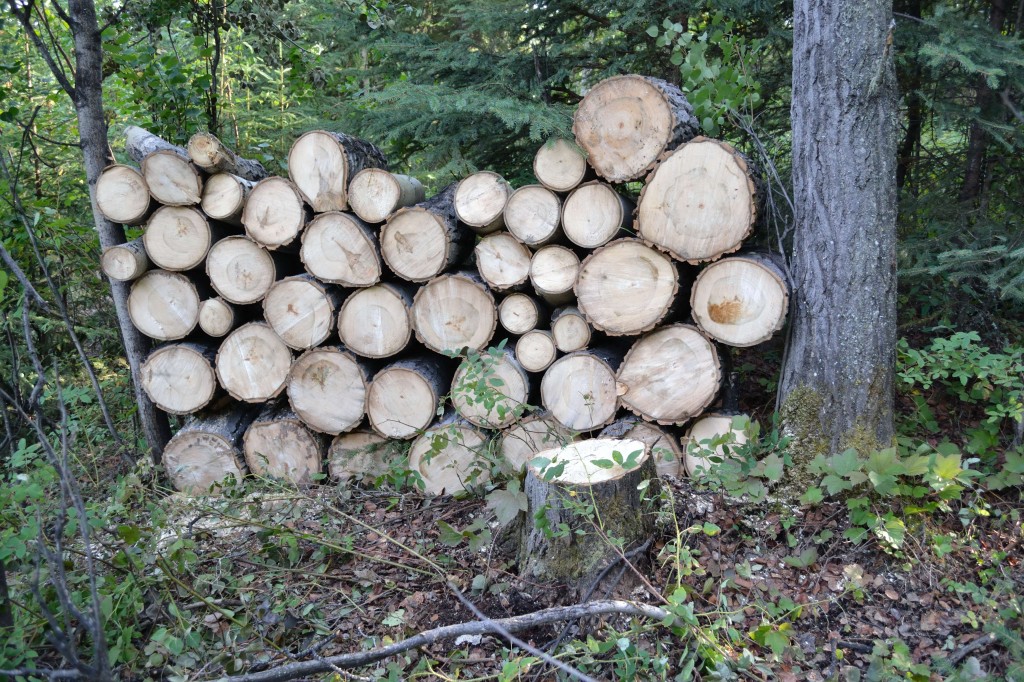During the past decade, things have been stressful for some of the trees in the boreal forests around Fairbanks. On average, our growing season is getting longer. Data from the Alaska Climate Research Center show that the growing season has increased from 85 to 123 days in the past century. But rainfall has not increased accordingly. In fact, data suggest that we’ve gotten about 11% drier over this same period. It is rather surprising that we have trees at all, given that we live in an Arctic desert, with average annual rainfall today of only about 11 inches. But our growing season is rather short, and therefore transpiration by the trees is brief enough to make that much water suitable for their growth and reproduction before a long period of dormancy each winter. However, coupled with our climatic changes we’ve also had some bad pest infestations. For about the past decade, aspen leaf-miner moths (Phyllocnistis populiella) have run rampant through the region’s trembling aspens (Populus tremuloides). Aspen leaves, normally green, have been silvered each summer for the past several years by the foraging trails within them of leaf miner larvae. These moths had an explosive arrival, population-wise, in the Fairbanks area, expanding rapidly into our area and inundating our rich aspen forests. Researchers at the university have found that this intensive leaf damage does have a negative effect on aspen growth. Oddly, this spring’s unusual weather seems to have knocked them back so much that we’ve enjoyed our normal green aspen leaves all summer. But, just eyeballing things, more trees than seem normal look stressed and are dying. And there also seems to have been an increase in the winds here. A decade or more ago winds were rarer; it was usually calm. Now, when the winds pick up it is not uncommon to hear a tree come crashing down in the forest. The aspens especially seem to have become vulnerable, and they tend to break off just below the ground, as though some form of upper root rot has weakened them intolerably.
Last summer I went up on the hillside above us and cut and piled up firewood from those that had fallen over the past couple of summers. As I slowly went about this, others joined their ranks. One morning after a small wind storm in the night I was surprised to see that one of the recently fallen had reached out and just scraped the edge of the house. It caused very little damage aside from wrenching the bird feeder free and throwing it to the deck. One would guess that this was a tragedy from the way the Black-capped Chickadees (Poecile atricapilla) were carrying on, but the Dark-eyed Juncos (Junco hyemalis) seemed to think the scattered seed was a party in their honor. As I looked over the situation I could see that this was a warning shot: this tree had been small, and only its top brushed the house. In front of it, leaning perilously, menacingly, and solidly aimed toward the house was its much larger elder.
I made a mental note that we had to get this bigger tree down in a proper direction before wind, gravity, age, bad health, and stress made its exit a home wrecker. I examined it periodically for months, wondering how my tree-felling skills might bring this about, but I’ve dropped enough trees that did not go down where I wanted them to fall that I naturally hesitated in case I brought about the very thing I was trying to prevent. A few years ago I’d been successful in taking down an old birch that threatened the house, but the practice tree I had cut right before had fallen in the opposite direction than that intended—because, I like to think, of excessive trunk rot (and perhaps a sudden burst of gravity). With a fresh lesson and undue confidence I went right ahead and dropped the next one—the closer one, and not yet as rotten at its core—in a perfect arc directly away from the house. Yay. But I did not still feel the winds of that success at my back.
 So we made an appointment with Kirk and Melissa Lewis, professional arborists, to come out and take down this old aspen. Rose and I were both home, and we enjoyed watching these consummate professionals at work. Good communication, top-notch skills, constant attention to proper safety and equipment, and smooth, efficient, and—to the tree—deadly work. Nice people, too.
So we made an appointment with Kirk and Melissa Lewis, professional arborists, to come out and take down this old aspen. Rose and I were both home, and we enjoyed watching these consummate professionals at work. Good communication, top-notch skills, constant attention to proper safety and equipment, and smooth, efficient, and—to the tree—deadly work. Nice people, too.
After looking things over for a few minutes, they set to work, with Melissa placing two come-alongs at the bases of trees angled in the direction they intended the tree to fall, while Kirk put on climbing boots and spikes and then harnessed up to climb. He started up and ran his smaller chain saw a little before beginning to climb so that any problems would be obvious before he was up the tree, then he dangled the saw and two ropes from lanyards clipped to his harness and climbed on up. He took out the branches off the trunk as he went.
 Soon enough, he was up about 40 feet, cutting the last couple of branches and tying the two ropes around the trunk. Then he unhooked his safety rope from around the trunk and rapelled back down. It looked fun. Then they connected the ropes to the come-alongs and tightened it all up. Kirk brought out the larger chain saw and made a small notch on the side they were aiming to fell it, then he quickly made two more cuts, deepening it. I didn’t ask, but I guessed that he was taking small bites to check the wood’s integrity. It was all good, fresh wood, as I’ve seen in many of its relatives on this hill that have toppled over in recent years. If it had been rotten, I’m sure he would have cut it a bit differently. With it notched about a third of the way in, he next made a straight cut on the back and then stopped with a good 2-3 inches yet to go. Melissa took up the slack and Kirk took off his gear and went to help her pull it over. It was a little stubborn, but soon enough—CRACK! Down it came, at about a 90-degree angle from where gravity alone would have toppled it into the house. It was great work, and Rose and I applauded.
Soon enough, he was up about 40 feet, cutting the last couple of branches and tying the two ropes around the trunk. Then he unhooked his safety rope from around the trunk and rapelled back down. It looked fun. Then they connected the ropes to the come-alongs and tightened it all up. Kirk brought out the larger chain saw and made a small notch on the side they were aiming to fell it, then he quickly made two more cuts, deepening it. I didn’t ask, but I guessed that he was taking small bites to check the wood’s integrity. It was all good, fresh wood, as I’ve seen in many of its relatives on this hill that have toppled over in recent years. If it had been rotten, I’m sure he would have cut it a bit differently. With it notched about a third of the way in, he next made a straight cut on the back and then stopped with a good 2-3 inches yet to go. Melissa took up the slack and Kirk took off his gear and went to help her pull it over. It was a little stubborn, but soon enough—CRACK! Down it came, at about a 90-degree angle from where gravity alone would have toppled it into the house. It was great work, and Rose and I applauded.
 A couple of days later, just for fun, I cored it to determine its age. It was a venerable tree, about 80 years old. I thought about this as I cut it up for firewood, enjoying the rich, pleasant smells of aspen bark and the fresh aspen sawdust. This was our fault, then—we were the bad neighbors. The tree had clearly grown happily in that spot for about 51 years before this wooden box for human occupation was built nearby. But as humans we won that neighbor dispute, and we now have a stump of happiness and a pile of firewood where there once stood a large, menacing worry. From our perspective, the real end of this story will occur in two winters, when we feed the dried remains into the wood stove to keep the house warm. As I stacked the heavy, solid firewood logs by the stump to dry, I thought about how instead of two possible negative outcomes we had achieved the best possible result. If we’d waited too long, of course, it would have been a stump of revenge as we embarked on home repairs. And if one cut down happiness and all that remained was a stump, well…nobody would intentionally cut down happiness, right? Instead we created a positive outcome by removing a worry and leaving a stump, and a substantial amount of firewood, to mark the occasion. However, aspen propagate from the roots, and this was a reasonably healthy, mature tree by all appearances, so perhaps the recent battle has gone to us but the war will continue on a different timescale over the coming decades. The answer to that philosophical question won’t be known until long after the smoke from this battle has gone up the chimney.
A couple of days later, just for fun, I cored it to determine its age. It was a venerable tree, about 80 years old. I thought about this as I cut it up for firewood, enjoying the rich, pleasant smells of aspen bark and the fresh aspen sawdust. This was our fault, then—we were the bad neighbors. The tree had clearly grown happily in that spot for about 51 years before this wooden box for human occupation was built nearby. But as humans we won that neighbor dispute, and we now have a stump of happiness and a pile of firewood where there once stood a large, menacing worry. From our perspective, the real end of this story will occur in two winters, when we feed the dried remains into the wood stove to keep the house warm. As I stacked the heavy, solid firewood logs by the stump to dry, I thought about how instead of two possible negative outcomes we had achieved the best possible result. If we’d waited too long, of course, it would have been a stump of revenge as we embarked on home repairs. And if one cut down happiness and all that remained was a stump, well…nobody would intentionally cut down happiness, right? Instead we created a positive outcome by removing a worry and leaving a stump, and a substantial amount of firewood, to mark the occasion. However, aspen propagate from the roots, and this was a reasonably healthy, mature tree by all appearances, so perhaps the recent battle has gone to us but the war will continue on a different timescale over the coming decades. The answer to that philosophical question won’t be known until long after the smoke from this battle has gone up the chimney.

